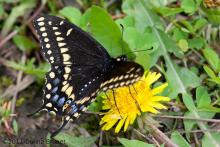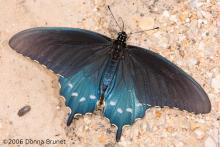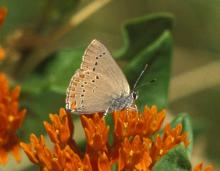Butterflies and Moths
Media

Species Types
Scientific Name
About 75 species in North America north of Mexico
Description
Missouri has 16 species of saturniid, or giant silkworm moths. Many of them are spectacular, including the cecropia, luna, buck, io, imperial, polyphemus, rosy maple, spiny oakworm, and royal moths.
Media

Species Types
Scientific Name
More than 12,000 species in North America north of Mexico
Description
Learn about moths as a group. What makes a moth a moth? How are moths different from butterflies? What are the major groups of moths?
Media

Species Types
Scientific Name
Polygonia progne
Description
The gray comma is easy to ID if you can see the underside: it is charcoal gray with many fine dark streaks, and its comma marking is L-shaped and narrows to a fine point at each end.
Media

Species Types
Scientific Name
Polygonia interrogationis
Description
The question mark is named for the shape of the small silver mark on the lower side of the hindwings. It flies in Missouri April to November.
Media

Species Types
Scientific Name
Anaea andria
Description
As it rests with wings closed, the goatweed leafwing mimics a dry, dead leaf. But when it flutters around, it flashes bright rusty orange on the top side of its wings.
Media

Species Types
Scientific Name
Polygonia comma
Description
The eastern comma is named for a small white mark on the underside of the hindwing. It flies spring through fall, and even in winter, on warm, sunny days.
Media

Species Types
Scientific Name
Papilio polyxenes
Description
Most gardeners meet the black swallowtail sooner or later, because parsley, carrot, fennel, and dill are favorite food plants of the caterpillars.
Media

Species Types
Scientific Name
Battus philenor
Description
The pipevine swallowtail is ignored by most predators because of its acrid body juices. Several other butterflies benefit by looking strikingly similar.
Media

Species Types
Scientific Name
Pterourus troilus
Description
Spicebush swallowtails are beautiful large black butterflies with beautiful iridescent blue-green on the hindwings. The caterpillars eat the leaves of sassafras and spicebush.
Media

Species Types
Scientific Name
Satyrium titus (syn. Harkenclenus titus)
Description
The coral hairstreak is the only Missouri hairstreak lacking hindwing “tails” and without a blue spot on the outer hindwing edge.
See Also


Media

Species Types
Scientific Name
About 1,500 species in North America north of Mexico
Description
Adult caddisflies are mothlike. Their larvae are aquatic and build portable, protective cases out of local materials, including grains of sand, bits of leaves and twigs, and other debris.
Media

Species Types
Scientific Name
Corydalus cornutus
Description
Adult eastern dobsonflies are huge and mothlike, with large wings and a weak, fluttery flight. The fiercely predaceous aquatic larvae, called hellgrammites, are well-known to anglers, who often use them as bait.
About Butterflies and Moths in Missouri
Butterflies, skippers, and moths belong to an insect order called the Lepidoptera — the "scale-winged" insects. These living jewels have tiny, overlapping scales that cover their wings like shingles. The scales, whether muted or colorful, seem dusty if they rub off on your fingers. Many butterflies and moths are associated with particular types of food plants, which their caterpillars must eat in order to survive.





















